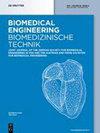Computer-aided diagnosis system for retinal disorder classification using optical coherence tomography images
IF 1.8
4区 医学
Q4 ENGINEERING, BIOMEDICAL
引用次数: 5
Abstract
Abstract The incidence of vision impairment is rapidly increasing. Diagnosis and classifying retinal abnormalities in ophthalmological applications is a significant challenge. Using Optical Coherence Tomography (OCT), the study aims to develop a computer aided diagnosis system for detecting and classifying retinal disorders. Choroidal neovascularization, diabetic macular edema, drusen, and normal cases are the investigated groups. Both deep learning and machine learning are combined to build the system. The SqueezeNet neural network was modified to extract features. The Support Vector Machine (SVM), K-Nearest Neighbor (K-NN), Decision Tree (DT), and Ensemble Model (EM) algorithms were used for disorder classification. The Bayesian optimization technique was also used to determine the best hyperparameters for each model. The model’ performance was evaluated through nine criteria using 12,000 OCT images. The results have demonstrated accuracies of 97.39, 97.47, 96.98, and 95.25% for the SVM, K-NN, DT, and EM, respectively. When results are compared to relevant studies in terms of accuracy and tested samples, they show superior performance. As a result, a novel computer-aided diagnosis system for detecting and classifying retinal diseases has been developed, reducing human error while also saving time.基于光学相干断层成像的视网膜疾病分类计算机辅助诊断系统
摘要视力障碍的发病率正在迅速上升。诊断和分类视网膜异常在眼科应用是一个重大的挑战。本研究旨在利用光学相干断层扫描(OCT)技术,开发一种检测和分类视网膜疾病的计算机辅助诊断系统。脉络膜新生血管、糖尿病性黄斑水肿、黄斑水肿和正常病例为研究组。将深度学习和机器学习结合起来构建系统。对SqueezeNet神经网络进行改进,提取特征。使用支持向量机(SVM)、k -最近邻(K-NN)、决策树(DT)和集成模型(EM)算法进行无序分类。采用贝叶斯优化技术确定各模型的最佳超参数。使用12,000张OCT图像,通过9项标准评估模型的性能。结果表明,SVM、K-NN、DT和EM的准确率分别为97.39、97.47、96.98和95.25%。当结果与相关研究在准确性和测试样本方面进行比较时,它们显示出优越的性能。因此,开发了一种用于检测和分类视网膜疾病的新型计算机辅助诊断系统,减少了人为错误,同时也节省了时间。
本文章由计算机程序翻译,如有差异,请以英文原文为准。
求助全文
约1分钟内获得全文
求助全文
来源期刊
CiteScore
3.50
自引率
5.90%
发文量
58
审稿时长
2-3 weeks
期刊介绍:
Biomedical Engineering / Biomedizinische Technik (BMT) is a high-quality forum for the exchange of knowledge in the fields of biomedical engineering, medical information technology and biotechnology/bioengineering. As an established journal with a tradition of more than 60 years, BMT addresses engineers, natural scientists, and clinicians working in research, industry, or clinical practice.

 求助内容:
求助内容: 应助结果提醒方式:
应助结果提醒方式:


